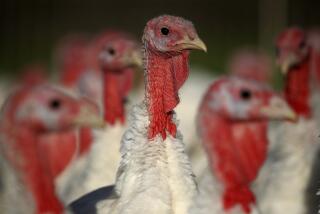When the U.S. and Russia tussle, American chickens often pay

The Obama administration says Moscow’s ban on certain food imports from the West amounts to a “cruel irony” that will only limit Russian consumers’ access to a major part of their food supply.
The feathers are really flying now.
In response to U.S.-led sanctions against Russia, Moscow is banning imports of U.S. chicken.
The order issued Wednesday is expected to block access to America’s third biggest poultry export market for a year. The ban comes after Washington and its European allies imposed targeted sanctions on Russia’s energy, banking and defense industries to punish Moscow for its support of separatists in neighboring Ukraine.
The move has become something of a tradition every time relations between Moscow and Washington turn frosty.
In 2008, Russia banned several American poultry producers over U.S. support of Georgia in the South Ossetia War. Moscow briefly imposed a broader ban in 2002 in response to U.S. steel tariffs.
When former Russian President Boris N. Yeltsin sought reelection in 1996, Moscow blocked U.S. chicken to curry favor with domestic producers.
Chicken is vulnerable because it’s one of the few things the U.S. sells to Russia.
“It’s the damndest thing. When Putin came to visit the U.S., he and Obama were talking about nuclear proliferation one second and then poultry the next,” said Mike Cockrell, chief financial officer and treasurer for Sanderson Farms Inc., a Mississippi company that sends about 40,000 metric tons, or 2% of its total annual production, to Russia
“We don’t want to lose them. They’re a good customer,” Cockrell said of Russia. “But if we do, the industry will find alternative markets. My guess is every company in the industry is calling to find those.”
Chicken wasn’t always this contentious. The bird was once offered as an olive branch to post-Soviet Russia. President George H. W. Bush sent tons of dark poultry meat to Russia in 1991 as food aid, earning the food its enduring nickname: “Bush Legs.”
But the country’s heavy appetite for U.S. poultry evolved into a symbol for Russian nationalists, who scoffed at the idea of relying on meat from the former Cold War adversary.
In a move viewed as protectionist, Russia took the U.S. chicken industry to task in 2010 for rinsing its product in chlorine, a practice long banned in the European Union but common in the U.S. American producers agreed to stop the process for Russian-bound chicken.
The rule had a lasting effect. Russia accounts for only 7% of U.S. poultry exports today, down from 20% as recently as 2008 and 40% in the mid-1990s.
“We’re far less dependent on Russia today,” said Jim Sumner, president of the USA Poultry & Egg Export Council. He cited major growth in emerging markets such as Angola, which has seen its purchases of U.S. poultry grow fourfold in the last five years.
The U.S. poultry industry can also steer its products back home, where demand for chicken continues to grow because consumers view it as a healthier option and because beef prices remain at record highs.
It’s unclear yet if other U.S. agricultural exports will face resistance from Russia. President Vladimir Putin’s decree Wednesday sought to impose restrictions on agricultural products from all countries with sanctions on Russia.
Follow @dhpierson for more food and agriculture news.
More to Read
Inside the business of entertainment
The Wide Shot brings you news, analysis and insights on everything from streaming wars to production — and what it all means for the future.
You may occasionally receive promotional content from the Los Angeles Times.










